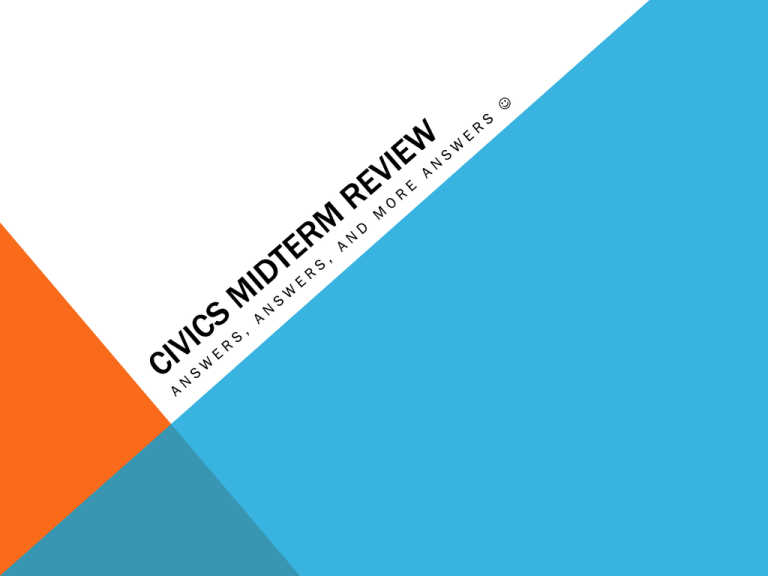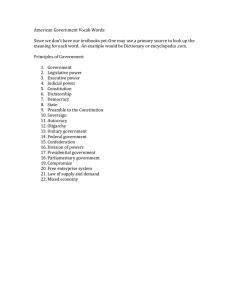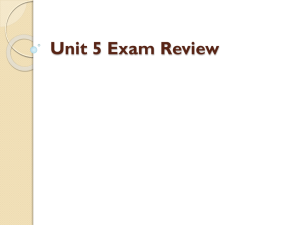Civics Midterm Review
advertisement

TIMELINE/FLOWMAP Document/Event Magna Carta Date 1215 Where? EnglandWritten by the king’s nobles (they were powerful enough to make him agree to it). Purpose Required King John of England to protect certain rights of the people Limited King’s powers (things he couldn’t do any more) Protected the rights of the people (Note: While these goals were not achieved, the document became an important symbol to show that the government was bound by law) Main points Rule of constitutional lawThe government must follow laws, too. Created ParliamentBeginning of representative government Beginning of separation of powers/checks and balances. Governments are based on an agreement or contract between the ruler and people to be ruled. (Just like social contract!) TIMELINE/FLOWMAP CONT’D. Enlightenment 1600- This 1700s was not a docume nt, but a time period in Europe. People started looking outside of the church for answers. Philosophers, Locke & Montesquieu, began to share their theories/ideas on human rights & government. Baron de Montesquieuseparation of powers, checks & balances John Locke- separation of church & state, social contract, natural rights, consent of the governed TIMELINE/FLOWMAP CONT’D. Mayflower Compact 1620 American coloniesAboard the Mayflowe r ship by settlers of Plymouth Rock. Set up a government and write first written laws for the new settlers arriving at Plymouth Rock (now Provincetown Harbor, Cape Cod, Massachusetts) Fair and equal laws for the general good of the settlement Will of the majority (democracy = majority rules) Social contract where the settlers consented to follow the Compact’s rules for the sake of the survival of the new colony (first form of selfgovernment) John Adams and others have referred to it as the foundation of the U.S. Constitution TIMELINE/FLOWMAP CONT’D. English Bill of 1689 EnglandRights (An Act Written by Parliament Declaring the Rights and Liberties of the People/Subje cts) A written document securing the rights/freedoms of the people. Lists rights for citizens and permanent residents of a constitutional monarchy (England) Included the right to petition the monarch (seek change or improvement) Included the right to bear arms in defense Emphasizes the importance of the consent (agreement) of the people Influenced the U.S. Bill of Rights (1791) TIMELINE/FLOWMAP CONT’D. Virginia Declaration of Rights 1776 American colonieswritten by several founders in Virginia Founders used the English Bill of Rights to help them draft individual rights colonists should have. It influenced many documents- Thomas Jefferson referred to it while writing the Declaration of Independence & it was used while writing the Bill of Rights in the US Constitution. TIMELINE/FLOWMAP CONT’D. “Common Sense” by Thomas Paine (published anonymously) 1776 American colonies Challenged the authority of the British government and the royal monarchy (includes Parliament) Published anonymously, the pamphlet encouraged that the colonists declare their independence from the British crown (Enough’s, enough! Stand up for yourselves!!!) Supported a movement for sovereignty (rule) of the people, a written constitution, and effective governmental checks and balances Placed the blame for the British colonists on King George III TIMELINE/FLOWMAP CONT’D. Declaration of Independence 1776 United States of America Written by Thomas Jefferson to the British government, declaring the independence/freedom of the colonies from British rule. The American colonies become the United States of America. Explains purpose of government and the role gov. should play in people’s lives (natural rights, consent of the governed, social contract, limited government/protections) Lists complaints against King George III, Parliament, & the British people TIMELINE/FLOWMAP CONT’D. Articles of Confederation 1777- United 1789 States of America An agreement among the 13 founding states that established the United States of America as a confederation (our first form of government) and served as its first constitution. Created a weak government with many problems: Congress/legislative branch only, each state had its own laws and type of $, state governments were stronger than national government (Congress), no court system, no president. TIMELINE/FLOWMAP CONT’D. U.S. Constitution 1789 United States of America America’s current framework for government, drafted in 1789 to resolve the problems under the Articles of Confederation. America’s government type is no longer a confederation, but a representative democracy (there’s majority rule of the people- voting- and everything else is decided by the representatives we elect). Federal government (national level) is more powerful than state government. Created 3 branches of government (legislative, executive, judicial) and checks & balances Preamble- introduces the purpose and the 7 main principles of the Constitution Articles- organizes the government and explains who does what and how Amendments- changes to the constitution. Include our individual freedoms and rights. Bill of Rights are amendments 1-10. ARTICLES OF CONFEDERATION/CONSTITUTION Problem with the Articles of Confederation Constitutional Solution The National Government (Congress) has no power No Power to Collect Taxes The Supremacy Clause (Article VI) A Stronger Congress (Article I) An Expressed Power (Article I, Section 8) An Expressed Power plus the Power to Regulate Instruments of Commerce (Currency- things like printing $) An Expressed Power (Article I, Section 8) A President Chosen Indirectly by Voters (Article II) Establishment of a Supreme Court and Grant of Power to Establish Lower National Courts (Article III) More Reasonable Amendment RulesNow a majority must agree (2/3 Congress & ¾ of States) No Power over Interstate and Foreign Commerce (trade) No Mandatory Power to Raise an Army No Independent Executive (No President) No National Court System The Amendment Process- Everyone had to agree for any change to happen What they were scared of National Government with Too Much Power The Solution Federalism- National government is superior to state government Separation of Powers “Separate Institutions Sharing Power” Bicameralism- Breaking Congress into 2 parts: the House of Representatives & the Senate Term Limits Checks and Balances Limited National Government- State governments and individuals have protections and freedoms 4. COMPARE THE RESPONSIBILITIES WITH THE RIGHTS OF US CITIZENS • Responsibilities: Pay taxes, vote, serve on juries (jury duty), obey laws, defend the nation, civic duty (giving back to the community…like Project Citizen) • Right: Vote, freedoms (speech, religion, assembly), bear arms, protection from government, representation in the government and court room 5. ILLUSTRATE THE “MELTING POT THEORY” M E LT I N G P OT TOSSED SALAD • immigrants coming into the country make an effort to become more “American”, adopting the ways and beliefs of the US, losing their native culture in the process. Immigrants try to fit in with the mainstream. • immigrants keep their culture and are proud of it, even after becoming a US citizen. US citizens are all different and unique, like the ingredients you’d put in a salad. US citizens, when put together, create a beautiful, tasty tossed salad! 6. LIST THE REQUIREMENTS FOR BECOMING A NATURALIZED CITIZEN. 18 years or older Continuous permanent resident for 5 years (3 if married) Show good moral character & agreement with ideals in US Constitution Swear an oath to the US Pass English/Civics test & interview 7. WHAT ARE THE PRINCIPLE CRITERIA FOR CITIZENSHIP UNDER THE 14TH AMENDMENT? “All persons born or naturalized in the United States, and subject to the jurisdiction thereof, are citizens of the United States and of the State wherein they reside.” Based on law of the soil – if born on US soil, you are automatically a citizen. 8. PROVIDE AT LEAST TWO EXAMPLES OF HOW FLORIDA MUNICIPALITIES (CITIES) LEVY (COLLECT) TAXES. Sales tax, property tax, utilities tax (water, electric, cell phones) 9. CREATE A CONTINUUM (LIKE A NUMBER LINE) SHOWING THE SPREAD IN POLITICAL IDEOLOGICAL THOUGHT (LIBERAL MODERATECONSERVATIVE) AND THE PARTIES GENERALLY IDENTIFIED WITH EACH TYPE OF IDEOLOGY. • Liberal- tend to be more open to new ideas and beliefs. Not very traditional. (Political party is generally Democratic) • Moderate- in the middle. (Political party tends to be Independent) • Conservative- tend to be more traditional in beliefs and ideas. Doesn’t usually like change. (Political party is generally Republican) 10. USE A FLOW MAP TO DIAGRAM THE POLITICAL NOMINATION PROCESS. Caucus, Primary election, National convention, platform issues/stances identified, Presidential campaign, general election, electoral vote 11. DESCRIBE THE CHARACTERISTICS OF POLITICAL CAMPAIGNS. Qualifications/Experiences- What is the candidates background, education, upbringing, moral values, professional experiences, accomplishments…what makes this person right for the job? Issue-based platforms- What issues/topics are important to the candidate? How do they feel about the issues and what is their plan for the issues? Debates- Candidates argue the points in their plans/beliefs, defending their opinions against opposing candidates Political Ads- Media is used to communicate information to the public so that they are able to make an informed decision and cast an educated, well-researched vote. 12. DESCRIBE THE INFLUENCE OF THIRD PARTIES ON THE POLITICAL PROCESS. Third parties are an option for people to turn to in the event they don’t agree with the 2 “main” political parties (Republican/Democrat) on the issues. Third parties bring more light to the issues, in the form of different opinions. Even if third parties don't win, a lot of people do vote for them, and that is votes taken away from the other party's votes, which has an impact on end election results. 13. HOW DOES YOUR LEVEL OF EDUCATION INFLUENCE YOUR VOTING HABITS? The more educated you are, the more likely you are to vote! 14. Define “suffrage.” The right to vote. 15. GIVE AN EXAMPLE FOR EACH OF THE 7 TYPES OF PROPAGANDA. Transfer/Testimonial- The act of relating something or someone we like or respect with a product or service. Glittering Generalities- The act of referring to words or ideas that evoke a positive emotional response from an audience. 15. GIVE AN EXAMPLE FOR EACH OF THE 7 TYPES OF PROPAGANDA. Plain Folks- The use of everyday people to sell a product or service. Speakers in ads appear to make the person to be one of the people. Bandwagon- Attempts to persuade the target audience to take a course of action, "Everyone else is taking." "Join the crowd." 15. GIVE AN EXAMPLE FOR EACH OF THE 7 TYPES OF PROPAGANDA. Name Calling- The use of names that evoke fear or hatred in the viewer. This technique links a person or idea to a negative symbol. Card Stacking- Strategy of showing the product's best features. Telling half-truths and emitting or lying about it's potential problems. 16. DESCRIBE HOW LOBBYISTS AND SPECIAL INTEREST GROUPS TRY TO INFLUENCE THE POLITICAL PROCESS. Think about it: You all became lobbyists for Project Citizen. What did you and your classmates do to gain support and influence others to approve your ideas? 17. DIAGRAM THE LEVELS OF GOVERNMENT. Federal (Washington DC- National Government) State (Tallahassee) Local (County/City) 18. List several ways you could volunteer in your community. This is checking to make sure you understand public policy and Project Citizen 19. What is the rule of law? Rule of law means that every citizen must follow the law, even those in charge. 20. Describe the rule of law and rights of citizens in a dictatorship vs. democracy. Dictatorship- Do as you’re told. No say in laws/rules. Democracy- People have a voice and may vote for rules/laws or those that create them. 21. Describe why the Code of Hammurabi was effective. Eye for an eye perspective Earliest known listing of rules/laws (from Babylonian times). Similar to Constitution. Rules and punishments were arranged by social status (slave versus free man). 22. Give three examples of intangible personal property (as in intellectual property, trademark, or copyright). Songs to download, movies, a patent for an invention, any idea you have 23. CREATE A DOUBLE BUBBLE MAP COMPARING/CONTRASTING THE VIEWS OF FEDERALISTS AND ANTI-FEDERALISTS INCLUDING THE SIGNIFICANT INDIVIDUALS INVOLVED IN THE DEBATE. FEDERALISTS • • • Alexander Hamilton & James Madison Strongly supported the Constitution as it was written and did not think a bill of rights was needed. Constitution limits government power enough & how could we possibly list ALL rights an individual has? ANTI-FEDERALISTS • George Mason & Patrick Henry • Felt that a bill of rights would prevent the central government from threatening states’ authority and oppressing citizens. • They thought that listing rights would help protect against the powerful central government taking away the freedoms they had fought a revolution to preserve. 24. LIST AND DESCRIBE THE COMPROMISES MADE DURING THE CONSTITUTIONAL CONVENTION. Great Compromise - Decision was made to split Congress/legislative branch into the House of Representatives & the Senate. A state’s representation in the House of Representatives is dependent on the population of the states (the more people the more representatives). In the Senate, each state has 2 representatives. Constitutional Compromise - Federalists & AntiFederalists compromised and added the Bill of Rights, resulting in the ratification, or approval, of the US Constitution. 25. DIAGRAM AND GIVE EXAMPLES OF THE SYSTEM OF CHECKS AND BALANCES. Legislative- Creates/makes laws. Includes the Senate and House of Representatives Executive branch- Enforces laws (makes sure people are following them). Includes the President and other executive departments (like Department of Education, Department of Homeland Security, etc) Judicial branch- Interprets laws (makes sure they’re fair and Constitutional). Includes the Supreme Court and the Justices (judges). Examples of Checks and Balances- anything showing one branch doing something and another branch signing off Legislative makes laws and executive approves them. Executive arrests people for breaking laws and judicial sets punishment. Legislative branch writes a law, the judicial branch says it’s unconstitutional. 26. CREATE A TREE MAP OF THE BILL OF RIGHTS 1- Freedoms: of speech, religion, assembly, press, petition the government 2- Bear arms 3- No soldiers in homes (anti-quartering act) 4- Protection from unreasonable search and seizure 5- Protection from self incrimination & due process (you must be notified why you’re being arrested/charges) 6- Right to attorney & jury trial in criminal cases 7- Right to trial by jury in civil cases 8- Protection from cruel & unusual punishment 9- Additional individual rights that may not be mentioned (like expectation of privacy) 10- Powers not given to the Federal government belong to the states or to the people. 27. Define the “supremacy clause” of the US Constitution and how it relates to ultimate sovereignty. Supremacy clause- basically that the US Constitution is the supreme law of the United States. It’s the “Big Daddy” of law that ALL citizens/states must follow. Ultimate sovereignty- means “supreme rule” 28. MAKE CONNECTIONS BETWEEN THE CONCEPTS OF “LIMITED GOVERNMENT” AND “POPULAR SOVEREIGNTY” Limited government- People are protected from government…there are certain things government CAN’T do. Popular sovereignty- the people are the rulers of our government. Literal translation is “rule of the majority” SO- it’s up to the majority of the people, those who participate in their governments anyway, to ensure government protections and limits so that people’s rights and freedoms are guaranteed today and tomorrow 29. PARAPHRASE THE PREAMBLE TO THE FLORIDA CONSTITUTION “We, the people of the State of Florida, being grateful to Almighty God for our constitutional liberty, in order to secure its benefits, perfect our government, insure domestic tranquility, maintain public order, and guarantee equal civil and political rights to all, do ordain and establish this constitution.” So what’s this saying? 30. WHAT IS THE DIFFERENCE BETWEEN POLITICAL PARTIES AND INTEREST GROUPS? POLITICAL PARTIES INTEREST GROUPS • Groups of people who have the same general idea of how the government should be run. • A group who represents people with special interests (women’s rights, environmentalists, senior citizens, religious groups, etc.) • These groups generally focus on a single issue. • Focus on many different issues.







